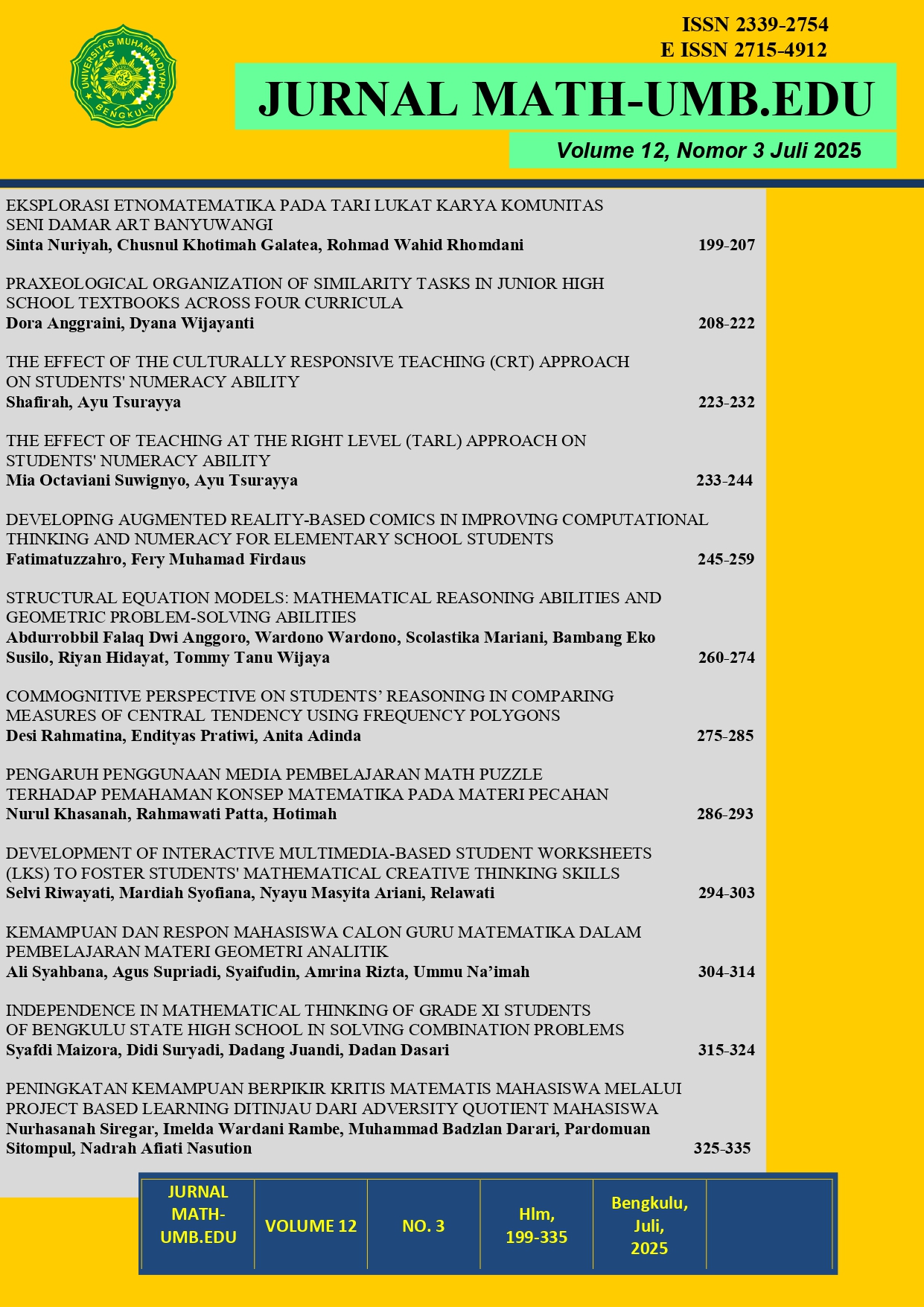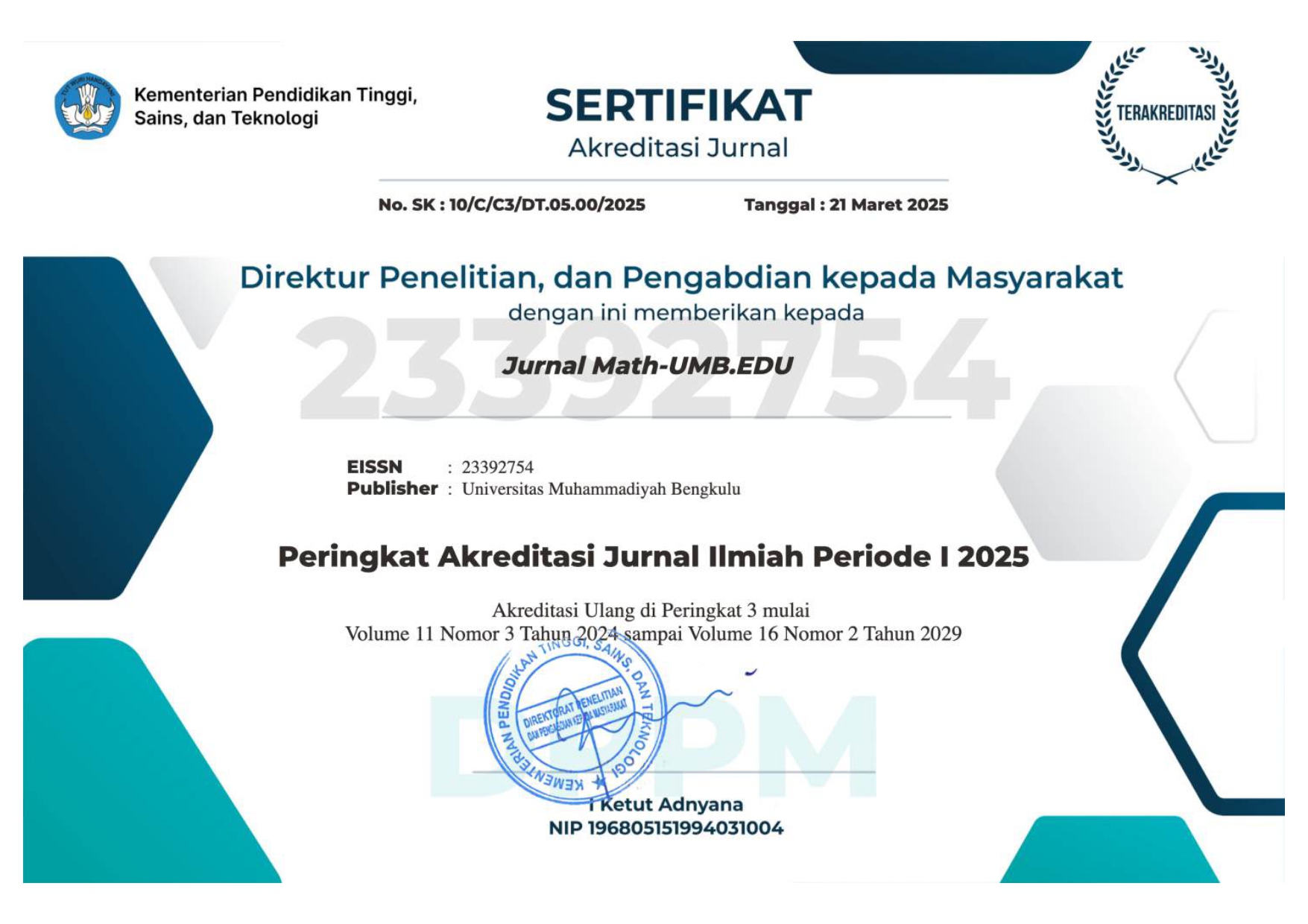COMMOGNITIVE PERSPECTIVE ON STUDENTS’ REASONING IN COMPARING MEASURES OF CENTRAL TENDENCY USING FREQUENCY POLYGONS
DOI:
https://doi.org/10.36085/mathumbedu.v12i3.8639Abstract
Measures of central tendency, such as the mean, median, and mode, are fundamental concepts in statistics that can be used to support decision-making. The purpose of this study is to describe how university students reason about measures of central tendency when comparing two age distributions of patients presented in the form of frequency polygons, from a commognitive perspective. This study employs a descriptive qualitative method with an exploratory approach. A total of 37 students participated in the study, four of whom were selected as research subjects—two representing the calculative category and two representing the visual-interpretative category. The research instruments consisted of one problem related to measures of central tendency and an interview guide. The problem included three questions, each presenting data in the form of frequency polygons. The data were thematically analyzed using Sfard’s commognitive framework, focusing on four components: word use, visual mediators, routines, and narratives. The findings reveal that students in the calculative category predominantly used visual mediators and routines. In contrast, students in the visual-interpretative category emphasized the use of word use to construct narratives.
Keywords: commognitive, reasoning, measures of central tendency, frequency polygon
References
Agus, M., Penna, M. P., Peró-Cebollero, M., & Guàrdia-Olmos, J. (2015). A proposal for the measurement of graphical statistics effectiveness: Does it enhance or interfere with statistical reasoning? Journal of Physics: Conference Series, 588(1). https://doi.org/10.1088/1742-6596/588/1/012040
Akar, N., & Işıksal Bostan, M. (2025). Nurturing Preservice Mathematics Teachers’ Reasoning about Measures of Central Tendency and Variability. Journal of Experimental Education, 93(3), 478–501. https://doi.org/10.1080/00220973.2024.2349213
Becerra, B. B., Reyes, S. V, Hernández, A. G., Elizondo, P. V, & Gonzalez, A. M. (2021). Good practice guide for data visualization in the area of descriptive statistics. 2021 Mexican International Conference on Computer Science, ENC 2021. https://doi.org/10.1109/ENC53357.2021.9534814
Biehler, R., Frischemeier, D., & Podworny, S. (2018). Elementary preservice teachers’ reasoning about statistical modeling in a civic statistics context. ZDM - Mathematics Education, 50(7), 1237–1251. https://doi.org/10.1007/s11858-018-1001-
Boels, L., Bakker, A., Van Dooren, W., & Drijvers, P. (2025). Secondary school students’ strategies when interpreting histograms and case-value plots: an eye-tracking study. Educational Studies in Mathematics, 118(3), 479–503. https://doi.org/10.1007/s10649-024-10351-3
Boonen, A. J. H., Van Wesel, F., Jolles, J., & Van der Schoot, M. (2014). The role of visual representation type, spatial ability, and reading comprehension in word problem solving: An item-level analysis in elementary school children. International Journal of Educational Research, 68, 15–26. https://doi.org/10.1016/j.ijer.2014.08.001
Cooper, L. L. (2018). Assessing Students’ Understanding of Variability in Graphical Representations that Share the Common Attribute of Bars. Journal of Statistics Education, 26(2), 110–124. https://doi.org/10.1080/10691898.2018.1473060
Cooper, L. L., & Shore, F. S. (2008). Students’ misconceptions in interpreting center and variability of data represented via histograms and stem-and-leaf plots. Journal of Statistics Education, 16(2). https://doi.org/10.1080/10691898.2008.11889559
Das, G. P., & Das, M. (2015). Promoting “Mean”: A desire regulating mechanism for managers. Purushartha, 8(2), 50 – 57. https://www.scopus.com/inward/record.uri?eid=2-s2.0-84962735526&partnerID=40&md5=1244b627e9057bb517a4a205a9ec644e
Delastri, L., & Lolang, E. (2023). Students ’ Conceptual Error and Procedural Error in Solving Algebraic Problems. Multicultural Education, 9(1), 18–24. https://doi.org/10.5281/zenodo.7508092
Frain, J. (2025). Statistical concepts. In ABC of Evidence-Based Healthcare. https://doi.org/10.1002/9781394219346.ch6
Garfield, J. (2002). The challenge of developing statistical reasoning. Journal of Statistics Education, 10(3), 1–12. https://doi.org/10.1080/10691898.2002.11910676
Holt, M. M., & Scariano, S. M. (2009). Mean, median and mode from a decision perspective. Journal of Statistics Education, 17(3). https://doi.org/10.1080/10691898.2009.11889533
Jankowski, K. R. B., & Flannelly, K. J. (2015). Measures of Central Tendency in Chaplaincy, Health Care, and Related Research. Journal of Health Care Chaplaincy, 21(1), 39 – 49. https://doi.org/10.1080/08854726.2014.989799
Karaca, S. A., & Ay, Z. S. (2025). Investigation of Eighth Grade Students’ Performance on Tasks Involving Statistical Thinking About Measures of Central Tendency. Participatory Educational Research, 12(1), 18–42. https://doi.org/10.17275/per.25.2.12.1
Karatoprak, R., Karagoz Akar, G., & Borkan, B. (2015). Prospective elementary and secondary school mathematics teachers ’ statistical reasoning. International Electronic Journal of Elementary Education, 7(2), 107–124.
Landtblom, K. (2023). Opportunities to learn mean, median, and mode afforded by textbook tasks. Statistics Education Research Journal, 22(3). https://doi.org/10.52041/SERJ.V22I3.655
Landtblom, K., & Sumpter, L. (2025). Which Measure of Central Tendency Is Most Useful? Grade 6 Students’ Expressed Statistical Literacy. Statistics Education Research Journal, 24(2), 1–18. https://doi.org/10.52041/serj.v24i2.811
Leavy, A. M., & O’Loughlin, N. (2006). Preservice teachers’ understanding of the mean: Moving beyond the arithmetic average. Journal of Mathematics Teacher Education, 9(1), 53–90. https://doi.org/10.1007/s10857-006-9003-y
Parra-Fica, J. H., del Mar López-Martín, M., & Díaz-Levicoy, D. (2024). Measures of central tendency in primary education textbooks in Chile. Eurasia Journal of Mathematics, Science and Technology Education, 20(6). https://doi.org/10.29333/EJMSTE/14592
Patton, M. Q. (2002). Qualitative research & evaluation methods (3rd ed.). Sage Publications.
Pratiwi, E., Nusantara, T., Susiswo, S., & Muksar, M. (2022). Routines ’ errors when solving mathematics problems cause cognitive conflict. International Journal of Evaluation and Research in Education, 11(2), 773–779. https://doi.org/10.11591/ijere.v11i2.21911
Rahmatina, D., Nusantara, T., Parta, I. N., & Susanto, H. (2023). Students’ Reasoning about Variability When Comparing Two Sets of Data from the Perspective of Commognitive. International Journal of Instruction, 16(4), 1081–1098. https://doi.org/10.29333/iji.2023.16459a
Rahmatina, D., Nusantara, T., Prata, I. N., & Susanto, H. (2022). Statistical Reasoning Process of Students in Decision Making Using Commognitive Framework. Acta Scientiae, 24(3), 63–88.
Rosidah, Ketut Budayasa, I., & Juniati, D. (2018). An Analysis of Statistical Reasoning Process of High School Students in Solving the Statistical Problem. Journal of Physics: Conference Series, 1028(1). https://doi.org/10.1088/1742-6596/1028/1/012125
Rosidah, R., & Ikram, F. Z. (2021). Measure of Central Tendency: Undergraduate Students’ Error in Decision-Making Perspective. In International Journal of Education (Vol. 14, Issue 1, pp. 39–47). https://doi.org/10.17509/ije.v14i1.29408
Sauce, B., & Matzel, L. D. (2017). Inductive Reasoning. In J. Vonk & T. Shackelford (Eds.), Encyclopedia of Animal Cognition and Behavior (pp. 1–8). Springer, Cham. https://doi.org/10.1007/978-3-319-47829-6
Sfard, A. (2008). Thinking as Communicating: Human development, the growth of discourses, and mathematizing. Cambridge University Press.















